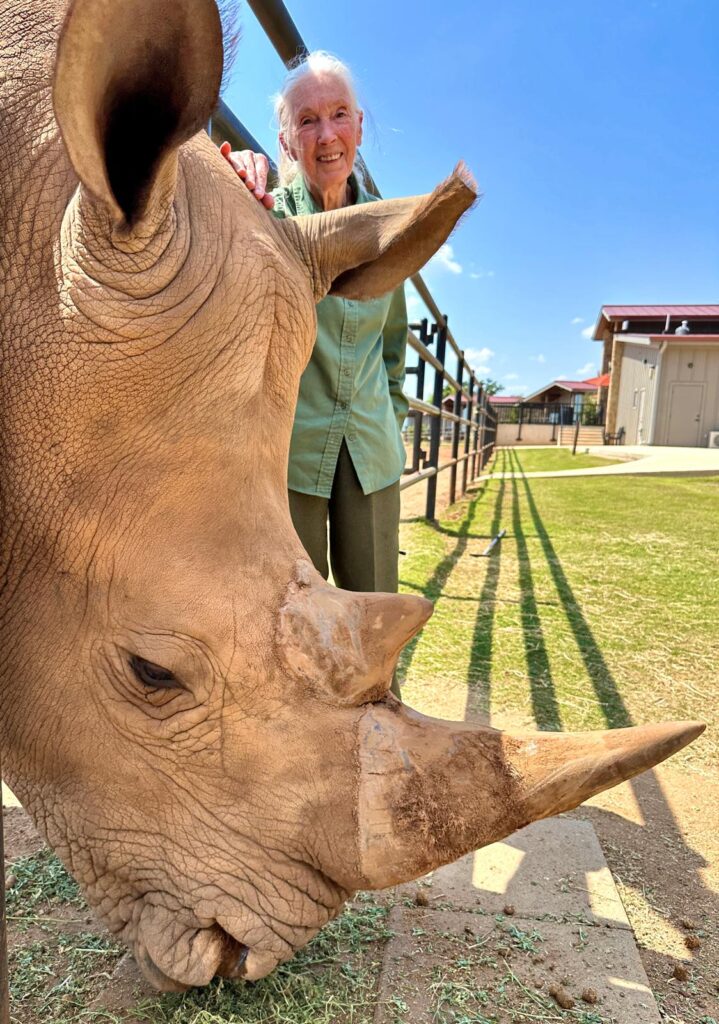On this World Rhino Day I would like to congratulate the Uganda government and the Ziwa Rhino sanctuary for the successful return of the white rhino to Uganda. And I was so honored to hear that one of Ziwa’s rhino calves has been named Jane. I am so looking forward to the day when I can meet her, face to face – or face to horn! But I have seen photos of her and she is, in my eyes, very beautiful.
Little – well, not so little! – Jane is lucky to be in a sanctuary where the needs of the local people are considered along with the needs of the wild animals. Because at Ziwa cattle owned by the local community are grazing alongside the rhino.
It just so happens that, as I write this, I am staying at Longneck Manor, created by my friend Rick Barongi, and home to 3 captive bred southern white rhinos. Here visitors learn that although these rhinos are huge and strong, they are also gentle. Like dogs, they love to be rubbed behind their ears and on the belly. Right now, outside the window of my cabin, I can see them. Fred and Barney are half brothers, both born in February. They come from a zoo in Florida and are very attached to each other and do almost everything together. Justin comes from California – and was born on the same day in the same year as Fred! Fred has come up to the railing and is scratching the side of his face on the fence post. They are such gentle animals, and it breaks my heart when I think of the thousands slaughtered for their horns.
Of course, because I have spent most time in Tanzania where there are no white rhinos, I have had more experience with black rhinos. I had my first meeting with a wild black rhino on the Serengeti Plains in 1957. In those days Dr. Louis Leakey and his wife Mary went for three months, every summer, to search for early human fossils in Olduvai Gorge. And that year they let me go with them. There were no roads or tracks and we saw many rhinos, along with all the other plains animals on the drive. To my surprise one came trotting towards us. I learned that she was known as Priscilla and that she loved pineapples! Every year, when she heard the Land Rover, she arrived to receive three of her favorite fruits (which, by the way, do not grow on the Serengeti)! Much more exciting was when I and another young assistant were walking on the plains, after a hard day searching for fossils, and suddenly came face to face with a male rhino. He was only about 18 yards away. His head came up and I could see him sniffing the air. Rhinos have poor eyesight, and the wind was blowing his scent towards us and not the other way round so he was clearly not sure what we were. He had probably never seen another human being. With his tail stiffly upright he ran back and forth in front of us three times – and then trotted away.
There are also rhinos in Asia. The greater one-horned rhino is now found mainly in India and Nepal. I saw one in the distance, drinking from a river, on a brief trip to India. The last remaining population of Javan rhinos are now only found in one protected area on the island of Java. Sumatran rhinos are found in Sumatra, with a few individuals remaining in Kalimantan, Indonesia. All five living rhino species have been brought to the brink of extinction mainly because of habitat destruction and the wildlife trade. The most tragic reason is that their horns fetch high prices on the black market because of the erroneous belief that a pinch of powdered horn is good for various ailments in Traditional Chinese medicine. It is even promoted as a cure for hangovers.
I am even more upset by trophy hunters. Permits are given by some governments to allow a few male rhinos, supposedly post reproductive age, to be sacrificed for “sport”. Even if it was true that this benefits conservation of the species, what about the individual, who was quietly living his or her life, harming no one – but then being brutally shot simply so that some wealthy hunter could have yet another head to hang on his wall. And just think, each rhino has a distinct personality, and they certainly show emotions such as anger, contentment and fear. I met one black rhino in a zoo who loved to paint when a brush was put in her mouth and she was given a large piece of white cardboard.
Fortunately today more and more groups are working to protect all 5 species of rhinos in the wild. Right now I’m looking at the three rhinos here at Longneck Manor, and thinking of little Jane and the other rhinos of Ziwa Sanctuary in Uganda, and I feel a sense of hope, knowing that they, at least, are content and safe. And all the visitors, at both places, fall in love with them and want to help.
Jane Goodall, PhD, DBE
Founder – the Jane Goodall Institute & UN Messenger of Peace




